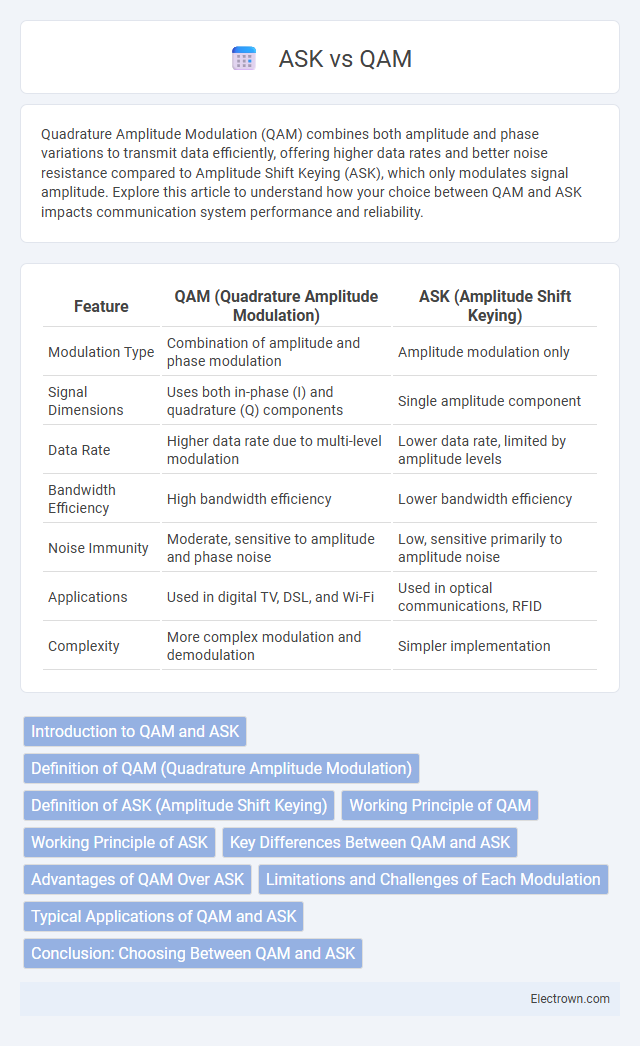Quadrature Amplitude Modulation (QAM) combines both amplitude and phase variations to transmit data efficiently, offering higher data rates and better noise resistance compared to Amplitude Shift Keying (ASK), which only modulates signal amplitude. Explore this article to understand how your choice between QAM and ASK impacts communication system performance and reliability.
Table of Comparison
| Feature | QAM (Quadrature Amplitude Modulation) | ASK (Amplitude Shift Keying) |
|---|---|---|
| Modulation Type | Combination of amplitude and phase modulation | Amplitude modulation only |
| Signal Dimensions | Uses both in-phase (I) and quadrature (Q) components | Single amplitude component |
| Data Rate | Higher data rate due to multi-level modulation | Lower data rate, limited by amplitude levels |
| Bandwidth Efficiency | High bandwidth efficiency | Lower bandwidth efficiency |
| Noise Immunity | Moderate, sensitive to amplitude and phase noise | Low, sensitive primarily to amplitude noise |
| Applications | Used in digital TV, DSL, and Wi-Fi | Used in optical communications, RFID |
| Complexity | More complex modulation and demodulation | Simpler implementation |
Introduction to QAM and ASK
Quadrature Amplitude Modulation (QAM) and Amplitude Shift Keying (ASK) are fundamental digital modulation techniques used in communication systems. ASK modulates the amplitude of a carrier signal to represent digital data, typically involving two amplitude levels for binary information, making it simple but susceptible to noise. QAM combines both amplitude and phase variations of the carrier wave, enabling higher spectral efficiency by encoding multiple bits per symbol, making it ideal for high-speed data transmission.
Definition of QAM (Quadrature Amplitude Modulation)
Quadrature Amplitude Modulation (QAM) is a modulation technique that combines both amplitude and phase variations of a carrier signal to encode data, enabling higher spectral efficiency compared to Amplitude Shift Keying (ASK). QAM modulates two carrier waves that are 90 degrees out of phase, allowing multiple bits to be transmitted per symbol by varying both amplitude and phase simultaneously. Understanding QAM's definition helps optimize digital communication systems by increasing data rates and improving bandwidth utilization for Your network needs.
Definition of ASK (Amplitude Shift Keying)
Amplitude Shift Keying (ASK) is a digital modulation technique where the amplitude of the carrier signal varies in accordance with the binary data being transmitted, representing digital bits through distinct amplitude levels. Unlike Quadrature Amplitude Modulation (QAM), which modulates both amplitude and phase, ASK solely modulates amplitude, making it simpler but more susceptible to noise and signal degradation. Understanding ASK's amplitude-based signaling helps optimize your communication system's design when channel conditions prioritize simplicity over robustness.
Working Principle of QAM
Quadrature Amplitude Modulation (QAM) works by combining two amplitude-modulated signals into a single channel, where each signal is shifted 90 degrees out of phase, known as in-phase (I) and quadrature (Q) components. This method allows QAM to efficiently encode data by modulating both the amplitude and phase of the carrier wave, significantly increasing the data rate compared to Amplitude Shift Keying (ASK), which only modulates amplitude. Your communication system benefits from QAM's enhanced spectral efficiency and robustness against noise, making it ideal for high-speed data transmission.
Working Principle of ASK
Amplitude Shift Keying (ASK) operates by varying the amplitude of a carrier signal to represent digital data, where different amplitude levels correspond to binary values. The signal's amplitude shifts between a high level (representing binary 1) and zero or a low level (representing binary 0), enabling simple modulation and demodulation. ASK's working principle relies on detecting these amplitude changes at the receiver to recover the transmitted bit stream effectively.
Key Differences Between QAM and ASK
Quadrature Amplitude Modulation (QAM) combines amplitude and phase variations to encode multiple bits per symbol, resulting in higher spectral efficiency compared to Amplitude Shift Keying (ASK), which only varies amplitude to represent data. QAM supports more complex constellations and higher data rates by using both amplitude and phase shifts, whereas ASK is simpler but more susceptible to noise and less bandwidth-efficient. The enhanced robustness and efficiency of QAM make it suitable for modern digital communication systems requiring high throughput.
Advantages of QAM Over ASK
QAM (Quadrature Amplitude Modulation) offers significant advantages over ASK (Amplitude Shift Keying) by providing higher spectral efficiency, enabling the transmission of more bits per symbol, which maximizes data throughput in limited bandwidth. It is more resilient to noise and signal degradation due to its combination of amplitude and phase variations, resulting in improved communication reliability compared to the amplitude-only changes in ASK. QAM's ability to support higher-order modulation schemes makes it the preferred choice for modern digital communication systems, including cable modems and wireless networks.
Limitations and Challenges of Each Modulation
QAM faces challenges such as higher susceptibility to noise and phase distortion, which limits its effectiveness in low signal-to-noise ratio (SNR) environments. ASK is simpler but struggles with amplitude variations and is more prone to signal fading and interference, reducing reliability in wireless communication. Your choice depends on balancing complexity against environmental robustness for optimal data transmission.
Typical Applications of QAM and ASK
QAM (Quadrature Amplitude Modulation) is widely used in digital television broadcasting, cable modems, and wireless communication systems due to its high spectral efficiency and ability to transmit multiple bits per symbol. ASK (Amplitude Shift Keying) finds typical applications in optical fiber communication, low-speed radio frequency systems, and remote control devices because of its simplicity and cost-effectiveness. Your choice between QAM and ASK depends on the required data rate and noise resilience for your communication system.
Conclusion: Choosing Between QAM and ASK
QAM offers higher data rates and improved bandwidth efficiency by combining amplitude and phase modulation, making it suitable for high-capacity digital communication systems. ASK, with its simpler implementation and robustness in low-noise environments, is ideal for basic or cost-sensitive applications. Selecting between QAM and ASK depends on system requirements such as data rate, signal quality, bandwidth availability, and complexity tolerance.
QAM vs ASK Infographic

 electrown.com
electrown.com